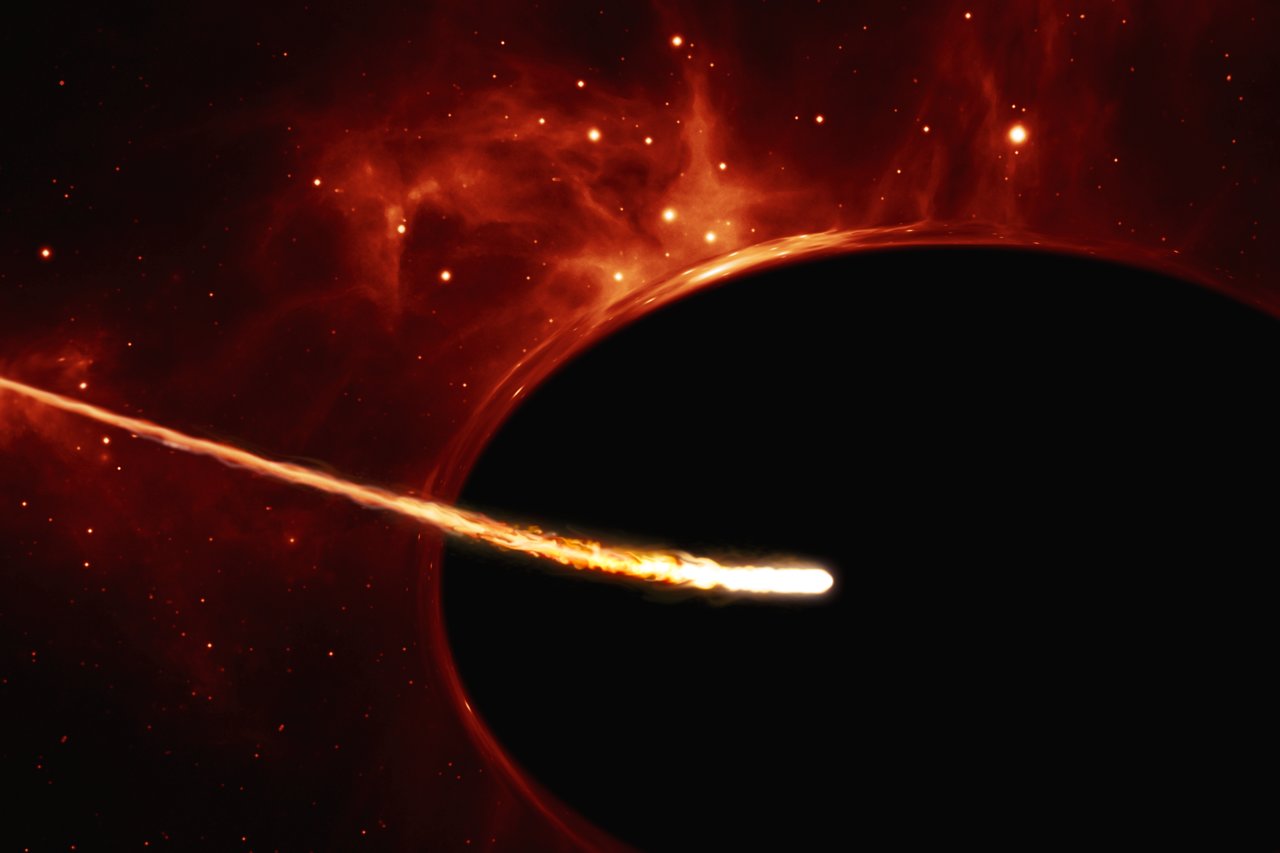Een extreem fel lichtsignaal uit de ruimte van juni 2015 dat werd toegeschreven aan de felste hypernova ooit waargenomen, is veroorzaakt door een ander ruimtefenomeen: een roterend superzwaar zwart gat, dat de tijd neemt om een ster te verschalken. Dat beschrijven de Deense astrofysicus Giorgos Leloudas en zijn co-auteurs, onder wie Peter Jonker (SRON, Radboud Universiteit) 12 december in vakjournaal Nature Astronomy. (English follows Dutch)

Het exotische fenomeen in het sterrenbeeld Indus aan de zuidelijke sterrenhemel heet ASASSN-15lh en voltrekt zich (nog steeds) op 3,8 miljard lichtjaar van de aarde. Het gaf op zijn helderste moment 50 keer zo veel licht als ons hele Melkwegstelsel. Het is ontdekt door twee telescopen die non stop heel het uitspansel afspeuren naar ongebruikelijke lichtuitbarstingen (ASAS).
Leloudas en zijn collega-auteurs bestudeerden aanvullende waarnemingen en vonden meerdere redenen om aan te nemen dat er een zwart gat aan het werk was. De ontwikkeling van de temperatuur en een nauwkeurigere plaatsbepaling van het fenomeen passen beter in het scenario van een gulzig zwart gat.
Het fenomeen komt uit het centrum van een wat ouder, gekalmeerd, melkwegstelsel. Daar komen normaal geen zeer zware sterren voor die tot supernova’s of hypernova’s leiden, maar juist wel een superzwaar zwart gat omringd door zonachtige sterren.
‘Normaal’ geeft het opeten van zo’n ster in zulke melkwegstelsels echter niet zo’n extreem fel schijnsel te zien. Het gaat snel en speelt zich af binnen de waarneem-horizon van het zwarte gat, waar het licht van de gebeurtenis niet kan ontsnappen. De ster is dan opeens weg.
“Tenzij het zwarte gat snel roteert”, verduidelijkt Peter Jonker. Dát maakt namelijk dat het zwarte gat de ster eerst uit elkaar trekt en dan pas naar binnen slurpt. Jonker: “Dat langzamere proces gaat wél gepaard met het afgeven van extreem fel zichtbaar licht.”
Metingen aan omringende sterren, mogelijk zodra de felle gebeurtenis wat bedaart, kunnen de aanwezigheid van het zwarte gat bevestigen. Als alles klopt, geeft het beschreven verloop van het uit elkaar trekken van een ster astronomen een nieuw instrument om de rotatie van zwarte gaten te bepalen.
NB: een supernova is het verschijnsel waarbij een ster explodeert. Een hypernova is een zeer heldere versie hiervan.
Brightest hypernova ever, found to be a rotating black hole ripping a star apart
An extremely bright light signal from space that was observed in June 2015 and was then ascribed to the brightest hypernova ever observed is actually being caused by a different space phenomenon: a rotating supermassive black hole taking the time to consume a star. Danish astrophysicist Giorgos Leloudas and his co-authors, one of whom is Peter Jonker of SRON, have described that process in an article that will be published on 12 December in the journal Nature Astronomy.
The exotic phenomenon in the constellation Indus in the southern night sky is called ASASSN-15lh and is still taking place 3.8 billion light years from Earth. At its brightest moment, it produced 50 times as much light as our entire Milky Way Galaxy. The phenomenon was discovered by two telescopes that continuously scan the firmament for unusual light emissions (ASAS).
Leloudas and his fellow authors studied additional observations and found several reasons to assume that a black hole was involved in the process. The evolution of the temperature and a precise positioning of the phenomenon fit better in the scenario of a voracious black hole. The phenomenon is occurring in the center of a somewhat old, calm galaxy. At such a location, there are usually no more highly massive stars that result in supernovas or hypernovas, but a supermassive black hole surrounded by sun-like stars is common.
However, the consumption of such a star in such galaxies does not ‘normally’ lead to such an extremely bright phenomenon. Instead, it occurs quickly and within the event horizon of the black hole, from which light caused by the event cannot escape. The star then suddenly disappears.
“Unless the black hole rotates quickly,” explains Peter Jonker. That makes it is possible for this black hole to first rip apart the star and only devour it afterwards. Jonker: “That slower process is associated with the emission of extremely bright visible light.”
Measurements of surrounding stars, which should be possible as soon as the bright event has subsided sufficiently, could confirm the presence of the black hole. If everything proves to be correct, the description of how a star is pulled apart can provide astronomers with a new instrument to determine the rotation of black holes.
NB: A supernova is a phenomenon during which a star explodes. A hypernova is a very bright version of this.


